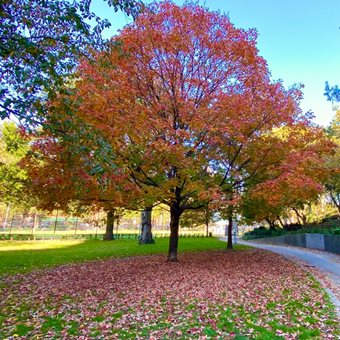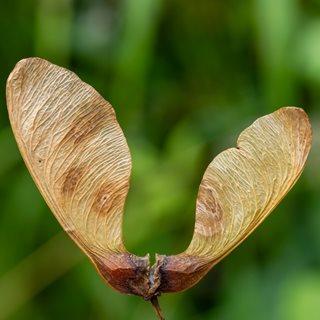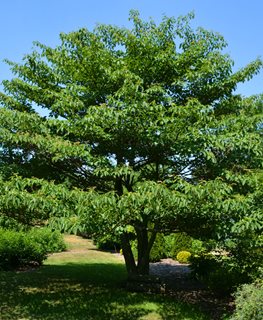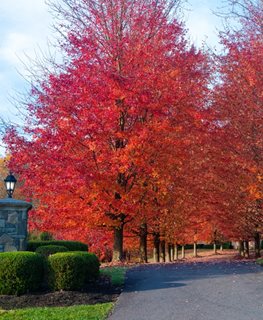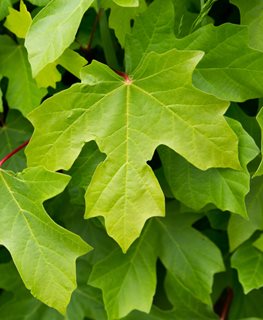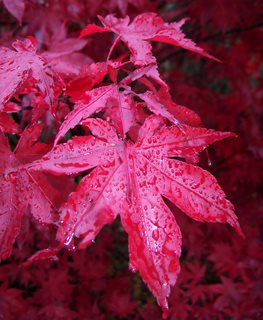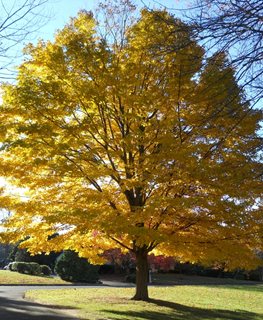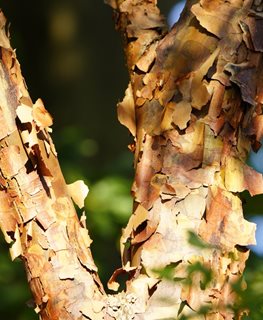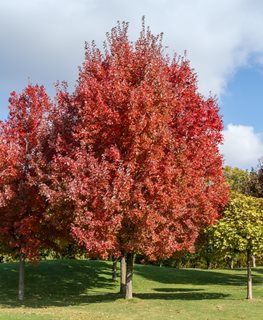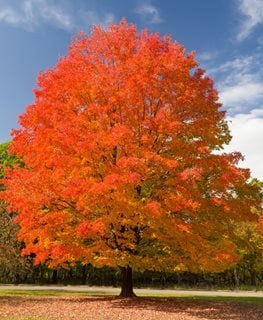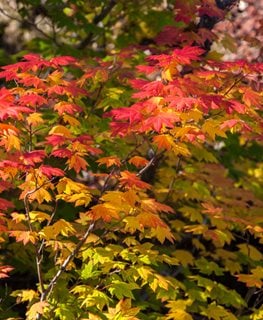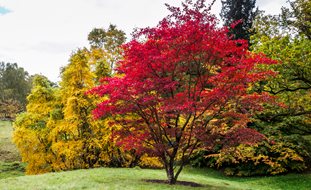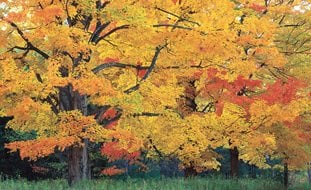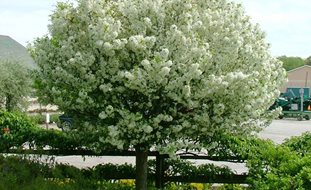How to Grow & Care For Maple Trees
Grow this classic landscape tree for long-lasting beauty and multi-seasonal appeal.Maples are one of the most common deciduous trees, and are found growing natively in temperate regions of the Northern Hemisphere, particularly North America, Europe, and Asia. This popular landscape tree is valued for its hardiness, adaptability, elegant structure, attractive lobed leaves, and brilliant fall color.
There are over 130 species of Acer and hundreds of varieties, ranging from statuesque bigleaf maples to diminutive Japanese maples. These beautiful trees provide food, shelter, and nesting habitat for songbirds and other wildlife. Maples are extremely versatile in the landscape, as shade trees, street trees, in mixed borders, woodland settings, and even containers. Here are some of the different types of maples, along with how to grow, plant, and use them in your yard.
On this page: Basics | Planting | Care | Varieties | Frequently Asked Questions
- BASICS
- HOW TO PLANT MAPLE TREES
- MAPLE TREE CARE
- MAPLE VARIETIES
- FREQUENTLY ASKED QUESTIONS
- DESIGN IDEAS
BASICS
Botanical name:
Acer spp.
Common names:
Maple; many species have their own common name
Plant type:
Deciduous tree
Zones:
2-10, depending on the variety
Exposure:
Full sun to partial shade
Habit:
Upright, shrubby, mounding, or weeping habit
Height/spread:
2 to 100 feet tall, 2 to 50 feet wide, depending on the variety
Bloom time:
Spring
Foliage:
Leaves are lobed or dissected, ranging from 1 to 12 inches across. The deciduous foliage occurs in colors of green, chartreuse, purple, burgundy, pink, yellow, or variegation. Many varieties have red, orange, or yellow fall color.
Flowers:
The tiny flowers of Acer can be showy or inconspicuous, appearing in early spring when plants are leafing out. Multi-petaled flowers grow in clusters along the branches, with an upright or dangling habit. Maple trees can be monoecious, with male and female flowers on the same plant, or dioecious, with male and female flowers on separate plants. Flower colors may be white, cream, yellow, chartreuse, or red.
Seeds:
Dangling clusters of winged seeds or fruits, known as samaras, appear after trees have finished flowering. They are also referred to as helicopter seeds for the whirling motion they make as they fall to the ground, similar to a helicopter’s moving rotor blade. This motion allows seeds to be further dispersed on wind currents. Seeds can be green, white, yellow, or red, turning brown or tan as they age.
PLANTING MAPLE TREES
Choose a maple variety that will perform well in your area and won’t outgrow its space. Follow these tips for planting maple trees.
When to plant:
Maple trees can be planted during cooler months in spring or early fall. Wait until all danger of frost is past in spring, or plant at least 6 weeks before your first freeze date in fall to allow roots time to establish.
Where to plant:
Choose a site with full sun, partial sun, or dappled shade, depending on the species. Provide protection from afternoon sun in hotter climates. Soil should be well-drained. Allow enough room for the spreading roots, and for plants to reach their full mature size. Avoid planting too close to homes, sidewalks, driveways and underground utilities, as the roots can cause damage. The root system will eventually become as wide as the mature tree canopy.
How to plant:
Loosen soil in the planting area and amend soil as needed. Dig a hole slightly shallower and at least 3 times as wide as the root ball to allow enough room for the shallow spreading roots.
If the planting hole is too small or roots are not spread out during planting, they can circle around themselves, a problem known as girdling. Maple trees are susceptible to root girdling, which can stunt growth, cause instability, or strangle the tree over time. Symptoms include abnormal trunk flare, small leaves, early leaf drop, canopy dieback, and roots that are visible above the ground. Some surface roots are normal.
Once the planting hole has been dug, remove the maple tree from its nursery pot and tease out roots if potbound; cut back circling roots to a point where they are straight, before they have started to circle. Place in the hole so the top of the root ball is at or slightly higher than ground level, making sure the roots are spread outward from the trunk. Fill in the planting hole with soil and gently tamp down to remove air pockets. Water plants regularly until established.
Spacing:
Space plants according to the mature size.
Pro tip on staking young trees
Janey Santos of Dig, Plant, Water, Repeat cautions against leaving the transport stakes attached to the trunk. “If you give too much support to a tree, it’s never going to develop the strength that it needs to handle life on its own.”
She recommends putting 2 to 3 other stakes approximately a foot away from the trunk and loosely tie them to the tree. That way, it's not fully supporting the trunk, but will help in case of heavy winds.
MAPLE TREE CARE
These deciduous trees have a shallow root system that will compete with other plants for water and nutrients. To grow healthy maple trees, provide a good location, proper planting and care.
Soil:
Acer can tolerate a range of soil conditions, but prefer average, well-draining soil with a neutral to slightly acidic pH between 5.0 and 7.0. For containers, use a high quality all-purpose potting mix.
Watering:
Acer grow best with regular moisture, though there are some drought-tolerant maple trees such as red maple. Provide supplemental water during prolonged heat and dry spells. Plants in containers will need more frequent watering than those in the ground. Avoid overwatering to prevent root rot and other diseases.
Fertilizer:
Once established, maple trees need little or no supplemental fertilizer. Younger trees will benefit from fertilizing to promote strong, healthy root growth. In early spring, apply a balanced slow-release fertilizer formulated for trees and shrubs according to package instructions.
Mulch:
Maples will benefit from a thin layer of mulch placed around the base of plants in spring. Use shredded bark or chips and apply in a 2- to 4-inch layer. This will provide nutrients, suppress weeds and retain moisture. Avoid placing bark against the trunk to avoid rot. Too much mulch can cause harm to roots, restrict oxygen, attract pests and diseases, and trap moisture.
Pruning:
Maples need little pruning and should be allowed to retain their natural shape and size. Remove dead, damaged, or diseased branches as they occur, and lightly shape plants as needed. Avoid topping or removing the central leader, which will destroy the natural shape and structure.
Wait until late spring or summer to prune younger specimens to minimize stress from sap loss. Prune judiciously to avoid a misshapen canopy. Use clean and sterilized pruners to prevent the spread of verticillium wilt or other diseases.
Diseases and pests:
When given the right growing conditions, maple trees will be more resilient to pests and diseases, though some species are more resilient than others. Pests include aphids, gall, maple borer, maple leafcutter, scale, and spider mites. Diseases include anthracnose, bacterial leaf scorch, bacterial leaf spot, powdery mildew, root rot, and verticillium wilt.
Some types of maples, particularly Japanese maple, red maple, and Norway maple are susceptible to verticillium wilt, a fungal disease that can cause branch dieback or kill plants. Avoid planting new maples or other susceptible plants on the site of a diseased plant, as verticillium wilt can remain in the soil.
TYPES OF MAPLE TREES
FREQUENTLY ASKED QUESTIONS
Are maple trees deer resistant?
Maple trees are generally considered to be deer resistant, though deer may graze on leaves and bark if they are hungry enough.
Are maple tree poisonous?
Maple trees are nontoxic to humans, dogs, and cats, but the ingestion of any non-edible plant may cause mild stomach distress. Red maple can be toxic to horses if bark or dried leaves are ingested.
How long do maple trees take to grow?
Maple trees can take several decades to reach maturity. Fast-growing varieties can produce 2 feet of growth in a single season. In general, maple trees will take 10 to 30 years to reach their full mature size.
Is a maple tree a good yard tree?
Some maple trees make better yard trees than others. Choose cultivars that won’t get too large and are easy to maintain.
What are the downsides of maple trees?
This deciduous tree is susceptible to some pests and diseases such as verticillium wilt. Some varieties may be prone to storm damage, cause root damage to homes and sidewalks, or be invasive in some areas.
How close to a house should a maple tree be?
Maples are shallow rooted and can cause damage to home and building foundations if planted too close. As a general rule, plant at least 15 to 20 feet away from a home.
What is the average lifespan of a maple tree?
Maples are long-lived trees that can survive up to 400 years. The average lifespan is 30 to 150 years.
Are all maple trees messy?
Maple trees can be somewhat messy, with dropped seeds that may self sow, and fallen leaves in autumn. To keep your yard clean, pick up seeds periodically and rake leaves in fall.
Can you tap any maple tree for syrup?
All maple trees produce sap, but most sap is not considered edible. Sugar maple has the sweetest sap, and is the most commonly used species to produce maple syrup and other edible maple products. Silver maple and red maple produce edible sap that is less sweet than sugar maple.
MAPLE TREE LANDSCAPING TIPS
For borders and landscapes:
Maple trees can be planted in a woodland setting, native landscape, mixed border, or as a showy focal point.
For slopes and hillsides:
With an extensive shallow root system, maple trees can help stem erosion on slopes and hillsides.
For containers:
Smaller varieties of maples such as dwarf Japanese maple can be planted in containers. Maples are prone to root girdling, which can strangle plants. Tease out roots before planting and provide adequate room for maple roots to grow.
Maple tree types come in a wide range of sizes and shapes to suit any landscape need. Here are some landscaping ideas:
- Plant native maples in a native landscape alongside other plants indigenous to your region.
- Use a showy variety such as coral bark maple or paperbark maple as a stunning focal point.
- A dwarf variety of Japanese maple tree can be planted in a small space or urban yard.
- Plant maples along a hillside and allow the vigorous roots to spread, which will help stem erosion.
- Adorn a woodland setting with maple trees for structure and shade.
- Plant a maple specimen to provide cooling shade during hot summer months.
- Include Japanese maples as an integral part of an Asian-style landscape.
- Use maple varieties such as coral bark maple and paperbark maple to provide winter interest in the landscape for four-season appeal.
- Plant a dwarf variety of Japanese maple in a container and place on a patio or deck for year-round color and structure.
- Include a smaller maple in a rain garden where it will thrive in the regular moisture.
- Larger species such as bigleaf maple and silver maple can be used on a spacious property for structure and shade.
Companion plants:
There are many plants that thrive alongside or underneath maples in the same growing conditions of full sun or partial shade, regular moisture and average soil. These include abelia, astilbe, camellia, coral bells, ferns, ginger, hakone grass, hardy geranium, hellebore, hydrangea, lungwort, periwinkle, phlox, rhododendron and sweet woodruff.
Avoid planting companion varieties too close to maple trees that would compete for water and nutrients.
ABOUT THE AUTHOR
Janet Loughrey is a veteran garden writer and photographer with over 25 years of experience, contributing to major publications like Garden Design, Better Homes and Gardens, and Sunset. A former Master Gardener, she brings hands-on expertise from gardening in a wide range of climates, from upstate New York to the Pacific Northwest.

